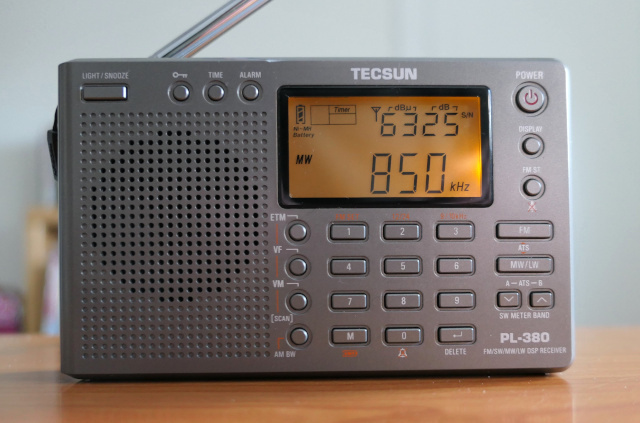
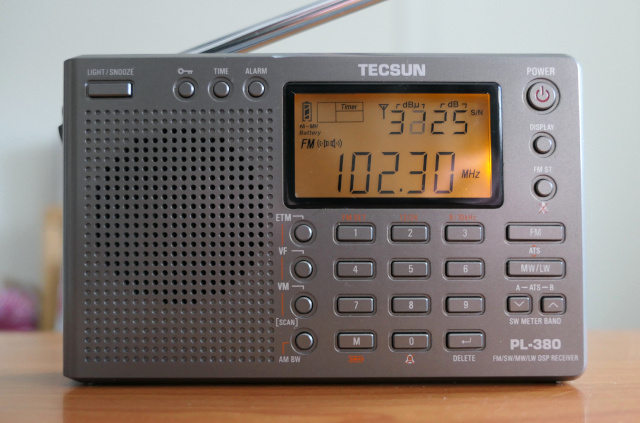
This review was revised in 2025, including new photos!
Introduction
I began my search for a good travel radio in 2009 after my trip to Australia. It seemed I could get either good FM reception, or good AM reception, but not both. Rural Australia had far fewer FM stations than the United States, so this was something of a sore point. Most Walkman-style FM radios have hideous performance. They combine the worst of poor sensitivity and a tendency to pick up spurious signals that don't really exist. The technical term for that last point is front-end overload, which happens when a powerful local signal proves to be more than the radio can handle.
So in 2010, I ordered the Tecsun PL-380 from a Hong Kong reseller, hearing about its good AM performance and its excellent FM reception capabilities, made possible through the use of digital signal processing technology, in particular the Silicon Labs SI4734 chip, which was relatively new at the time.
PL-380 performance and features
FM reception turned out to be very close to that of my reference hi-fi tuner, the NAD 4300 AM/FM tuner from 1990. The NAD 4300 still sounded better to my ears. AM performance is good, though not stellar. It cost $75 ($25 of that for shipping from a Hong Kong seller on eBay) in 2010 dollars, equivalent to about $108 in 2025.
A similar radio was the Grundig G8. It's also made by Tecsun, which carries it as the model PL-300WT. These were the first of many models. Almost all radios made from the 2010s and beyond are DSP-based.
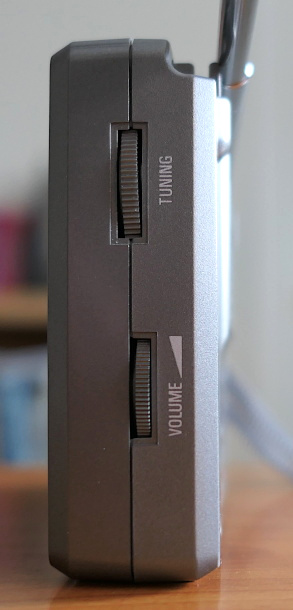
Aside from superior FM reception, the Silicon Labs chip offers the ability to select frequency bandwidths for AM reception, allowing you to choose the trade-off between frequency response and rejecting interference from adjacent stations. The Tecsun PL-380 offers multiple AM bandwidths - 1, 2, 3, 4, or 6 kHz. Wider bandwidths offer better sound fidelity, with the trade-off of being more subject to interference from nearby stations. At 6 kHz, music is fairly tolerable to listen to on AM.
For FM listening, you can turn stereo reception off. This is most useful with weak, noisy signals.
The PL-380 also offers direct keyboard entry of station frequencies, with a keypad that occupies much of the front of the radio. It also offers ETM, for Easy Tuning Mode. The PL-380 has two separate memory systems. One is the usual method where you manually enter presets. An auto-scanning function is also available for this purpose, though I prefer the manual method.
Easy Tuning Mode is a second auto-scanning method, but one that doesn't disturb the memory settings you already have. For example, I could take my radio to Los Angeles, with its San Francisco presets, and then set up auto-scanning in L.A. to pick up the stations there, without erasing my San Francisco pre-sets.
The built-in speaker is small and doesn't sound all that great. This is obviously a radio to use with headphones.
There's also an alarm clock, and a little fold-out stand.
The telescoping antenna should have been longer - for FM, it should be 30 inches. There is no jack for an external FM antenna, unlike some other Tecsun models.
AM reception is compromised somewhat by internally-generated digital noises. This wasn't uncommon among earlier generations of DSP-based radios. This phenomenon did not seem to affect FM reception, though it's possible those noises could have masked very weak signals.
The Tecsun PL-310ET, a "second edition" of the Tecsun PL-310, was released in 2013 and is nearly identical to the PL-380. Instead of a thumbwheel for tuning (right), used in the PL-380, the PL-310ET uses a knob. The PL-310ET also has an external antenna jack, which is lacking in the PL-380. Those two items, plus the placement of buttons on the front panel, seem to be the primary differences between the two models.
In my review of the PL-310ET, I compared them head-to-head along with the CC Skywave and CC Pocket radios from C. Crane. At the time, the PL-380 was the best performer of them all, though by a very small margin. Generally, the PL-380 could receive one or two more stations, whether on AM or FM, compared to the others.
The PL-380 is a well-balanced package, offering very good FM reception, and good AM reception and sound quality. The two memory systems are easy to use. The radio uses three rechargeable AA batteries; charging can be done with any USB charger. Over time, the PL-380 seems to drain batteries just a little faster compared to some other Tecsun models, so you should check the battery levels every couple of weeks or so to make sure the batteries don't run down altogether.
Until the smaller Tecsun PL-606 came along later in 2010, and after that, the Tecsun PL-505, this was my preferred radio for use while traveling. I'll have to admit that I've never been able to settle on just one radio for travel. That's why I kept buying new models.
Ten years later
The original version of this review was written about a year after I got the PL-380 in 2010. It was then revised at the end of 2014. In the meantime, I moved from California to Colorado, and obtained numerous other radios. Consequently, at the start of 2025, I decided it was time for a new revision.
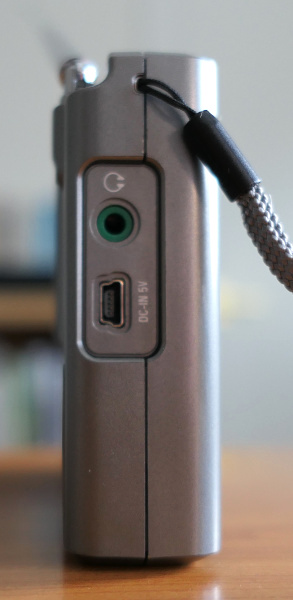
As of January 2025, the PL-380 was still available new from Amazon and from reputable Chinese sellers on eBay for prices around $50. It's interesting that the price held steady in nominal terms despite inflation.
A few things about the PL-380 are a bit dated now. For example, the port used for charging (left) is a USB "mini" port, which hasn't been commonly used for ten years or more. While I favor the use of AA batteries, including rechargeable metal hydride batteries, those seemed to have fallen out of favor with the Chinese radio manufacturers. In the 2020s, they're mostly using rechargeable lithium-ion batteries. For travelers, this is an inconvenience, because you can't put devices with lithium-ion batteries in checked luggage. You have to carry them on. So those newer radios had better be light and small.
The PL-380 has held up well over time. Tecsun has generally had good quality control, though there have been exceptions with some models. The telescoping antenna, however, feels loose. As a result, the antenna sometimes won't hold its position and slowly creeps toward the radio if it's in a somewhat horizontal position. I've tried to tighten the screw around which the antenna rotates, but have not had much success.
When any of the buttons on the keyboard are pressed, the audio level goes up a small amount, then goes back down when the button is released. While this isn't a big problem, it's an annoyance. I haven't encountered this on any other Tecsun model.
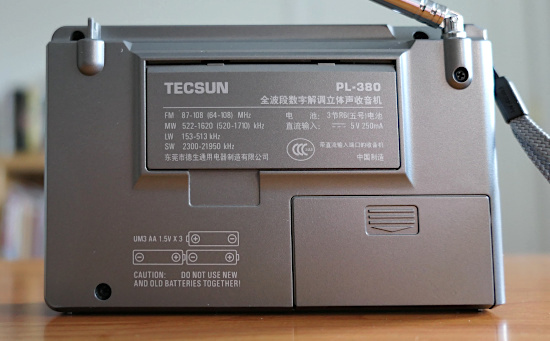
To be honest, the performance of the radio is dated now as well. It's still a very good radio, but there are now choices that are just a little bit better, including the Tecsun PL-320 (plus the PL-330) and the Qodosen DX-286 (as well as the Qodosen SR-286).
In my new Denver location, I performed a few head-to-head comparisons among several radios. (See the link for details.) While differences were slight, the newer radios, the Tecsun PL-320 and the Qodosen DX-286, performed better than the older DSP-based models on both AM and FM. In addition, they suffered less (if at all) from internally-generated digital noises, which were a problem on the PL-380, as well as the PL-310ET.
On the other hand, the older radios seem slightly easier to use, with a little less complexity. Thus, there may be a trade-off between performance and ease of use. Additionally, the older radios can use ordinary AA batteries and can be packed in one's luggage for travel; the newer radios with lithium-ion batteries can't.
In January 2025, the PL-380 was still listed in the line-up at tecsun-radios.com, along with several other enduring models. Still, I find myself wondering how much longer the PL-380 will be available new. It's been offered by Tecsun for 15 years, and Tecsun has brought out newer models in the last few years. It's interesting that Tecsun drops relatively few models from its line-up over time. As it is, I've wondered why Tecsun has kept with both the PL-310ET and the PL-380 since they are such similar models. Tecsun seems to take pride in having a wide range of radios, so it may be a while before some models are dropped.